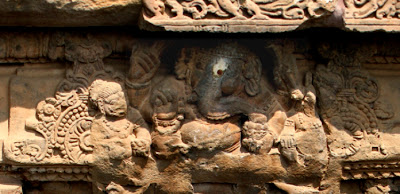IN THE TOWN OF TEMPLES :
A FORGOTTEN TEMPLE : SWARNAJALESWAR
SwarnaJaleswar temple .
A portion of the wall around the tiny court-yard is seen as well as the empty ground from where some photography is possible.
This temple will not be in the list of regular tourists cris-crossing Bhubaneswar. It does appear in the list of temples of this town - but it does not at all figure among the well-known ones. I could not trace one photo of this temple in the Internet ! Well - Internet dates this temple to 7th century AD , mentions its resemblance to that of Parasuramaswar temple and added that Kotitirtheswar temple is in its neighbourhood. Someone told me while I was planning my trip to Bhubaneswar that it is best approached through a narrow lane opposite to Parasuramaswar temple - a tenacious auto-rickshaw driver did take us to the right spot through a winding lane and not without several misses. You must not quite believe the simplicity of ' Bhubaneswar Heritage Walk : Route 2' of http://www.orissatourism.gov.in/heritagewalk.htm.
Fragment of a beautiful 'Mithuna Murti' .
One of the finest amorous couple in my collection.
This temple's height would be that of Parasuramaswar temple, but there is no Jagmohana here. Maintenance must have been much worse than that of Parasuramaswar temple. It must have been neglected for quite a long stretch . Now, with reconstruction, some of the wall-reliefs are noticeable to the occasional visitors. It is tucked away in a court-yard beyond a cluster of houses and photography of at least two sides is possible from a large empty ground on the side of the court-yard, in spite a tree in the vicinity. If a large building comes up in this large tract of land, this temple will be hidden from public view for ever.
Wall-relief of Ganesha and the smaller version on its top (above).
A bowl of fruits in front of the stool makes it interesting.
Pious persons are both on the top and central depictions
may be the ones who built this temple.
I found a wall-relief of Ganesha , badly mutilated, sitting on a pedestal with lions as its legs . There is another small Ganesha, quite intact, just above the head of this mutilated one. I found a bust of a Nagdevata too - much like the one I found @ the main temple of SriMukhalingam. I have noted Nagdevata is a regular feature of Orissa temples, but often without the status of a 'Parshadevata'.
NagaDevata
The broken and damaged wall-reliefs in the front of the temple are the
ones which deserve special mention.There is a wonderful Nataraja here -
most of it is lost - but one can imagine how beautiful it was when
intact. Nataraja is in tribhanga posture. Only a small part of the 'dola hasta' rsurvived the vandals and ravage of time. It has similarity with the 10-handed Nataraja above the Jagomohana of Parasurameswar temple , but more attractive . The influence is evident from the headless person playing drum in the left-hand corner.
Nataraja exquisite. Ithyphallic ,with his head tilting towards left,
finely chiseled face,eyes and matted hair.
We see a small portion of Siva's 'dola hasta' and
delicately crafted fingers and nails !
The simple waist-band and the hangings and index finger touching his own left thigh create an irresistible image.
I have taken some more photos which include a three-headed manifestation of Siva, several grotesque figures - human and animals, a four-armed god in 'yogasana', a two-armed 'Nataraja' or a dancer in the centre of a 'Bho' during reconstruction. Strangely, during reconstruction, someone has put the mutilated figures of a 3-persons amorous scene in two parts - one part each at two ends ( !) , only a pot-bellied short character intact. More such examples can be a subject of academic discussion, but what is intriguing is a 'Uma-Maheswar' reconstructed in such a manner that it becomes an interesting subject of discussion.
A jigsaw puzzle for all of us .
1 - Siva or Sivani with a trident in his/her right-arm, question - relevant in this depiction ,
2a - Siva/'Maheswar's face, 2 - part of his body,
3 - Uma's left arm, 3a -Uma's right leg,
4 - Ganesha, 5 -bull, 6 - Lion, 7 - a 'yogini',8 - a very fine and intact 'Bhringee'. There are many more figures in this wall-relief.
I invite readers of this blog, trained in Photoshop, to reconstruct this panel. My very 1st attempt is here :









































